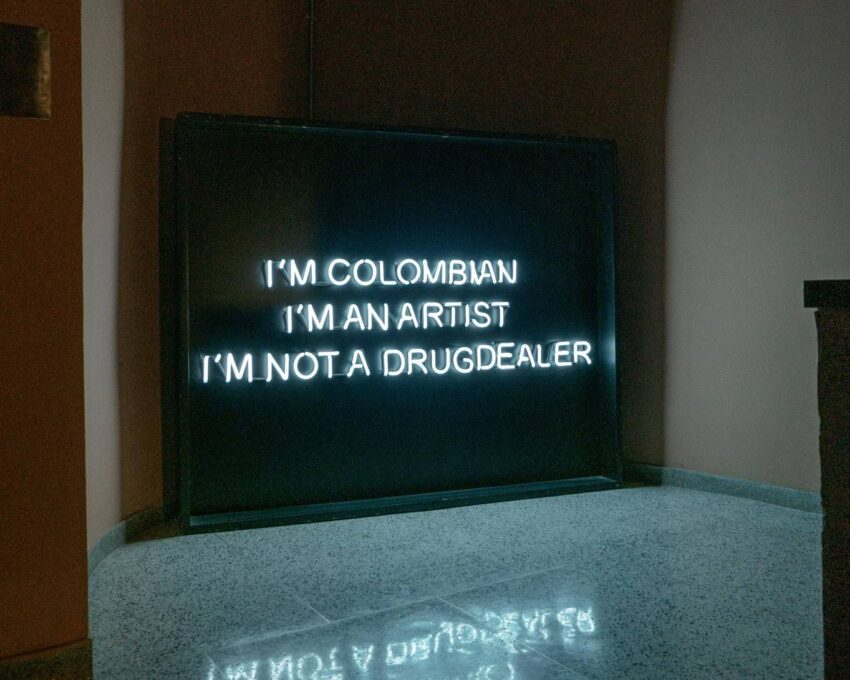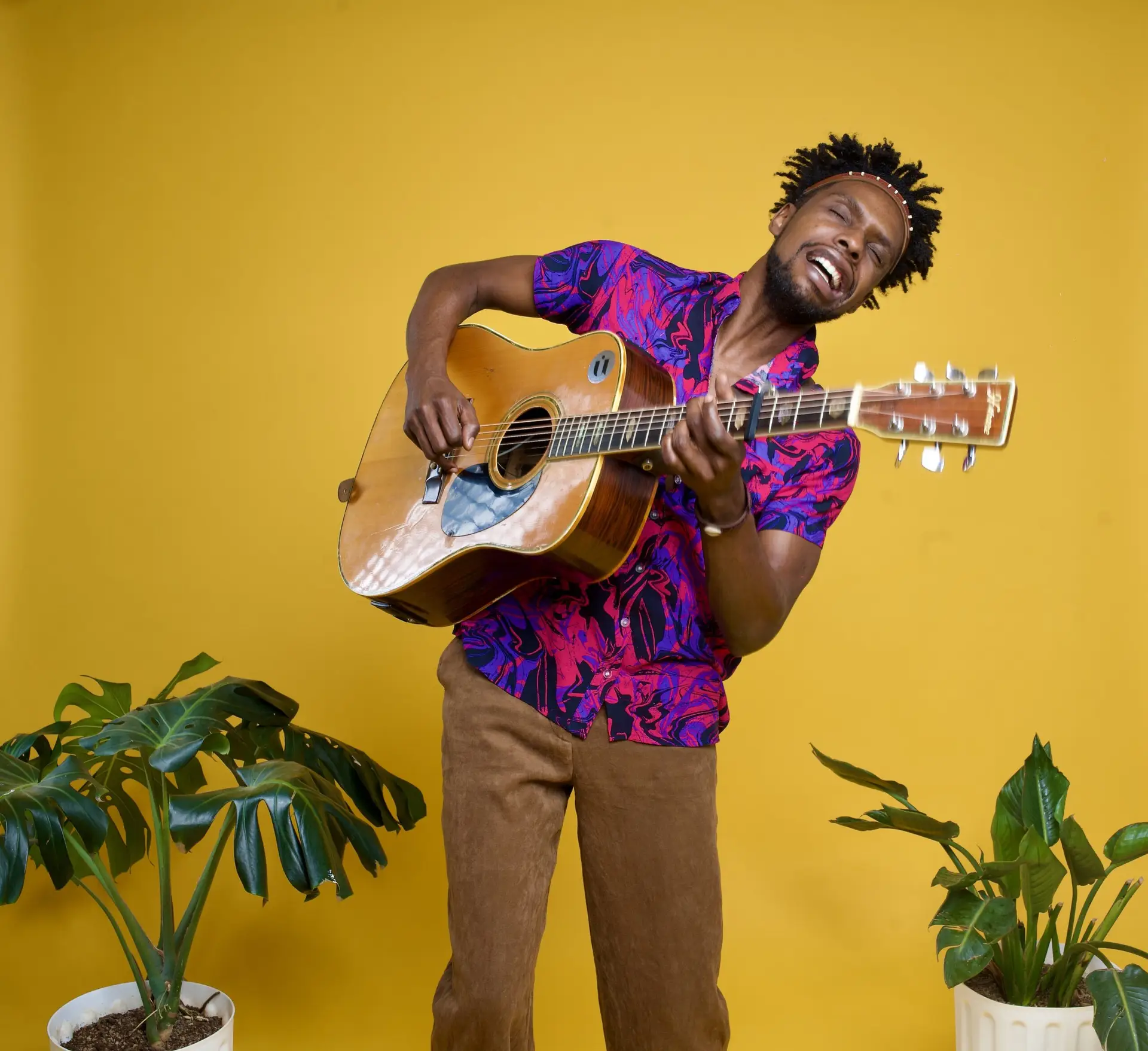
Turning Gods Into Superheroes | Tales Of The Orishas & Hugo Canuto
Last year, I visited Bahia, one of the most magical places I’ve ever been. Its capital, Salvador, is known as the blackest city outside of
One event marked Andrés Ribón’s youth: his parents’ divorce.
Andrés had many questions about it until he realized something.
Geometry taught him that lines are sequences of points. To continue the line, it needs another point in between.
That’s when Ribón became aware of his role in connecting the disconnected. And our interview is no exception.
In our case, the outer points were Andrés Ribón and me, connected by two points in the middle: a friend of his and one of mine.
My friend never met Andrés, and his friend never met mine. Nonetheless, they helped draw the line. This article is the result of that human connection.
Connection is also the theme of his latest exhibition, We Are Connected or Conexiones in Spanish.
The idea is that life flows through people.
For Andrés, this connection now happens on many different levels.
He connects his past with the future by incorporating his family and friends into his work.
But the connecting also takes place more literally, in museums, bars, and cafés, or online, where people see and discuss his work.

As an art student, you frequently draw single-line figures. It’s a doodling exercise, but it lacks any fundamental basis.
Andrés wanted to change this. He turned the simple exercise into a concept, which became the basis for his sculptures.
The single line represents our connection. “Humans live in communities. What affects us will also affect others. For some reason, we forgot about this. The pandemic emphasized this, which led to mental health issues and depression worldwide.”
The technical element of the single-line technique started with Picasso and Matisse. Although the two men were opposites in many ways, they greatly influenced each other’s work. Popularizing single-line paintings is a product of their competitive friendship.
Ribón told me that visitors have different interpretations of his work. It reminds some of the hieroglyphs from Egypt and Maya symbolism, whereas others see elements from Picasso and Matisse.
Although Andrés admires Matisse and Picasso – according to him, El Guernica is the most significant work of all time – he didn’t incorporate these influences on purpose. “We’re the product of our surroundings. Everything we see and experience finds a way into our work.”

When we started our interview, I told Andrés that I love Jaume Plensa and that his work reminds me of him. Andrés understood this and mentioned I wasn’t the first to say that. He, himself, is also a big fan.
Although most people mean it as a compliment, some use it as criticism. They don’t like ‘copycats.’
Andrés had an interesting response. He believes that nothing is new. Everything new is something that already exists with a personal touch.
Andrés quoted one of his other inspirations, Jorge Drexler. In his song Telefonía, Drexler sings:
“Aunque todos creen que han inventado algo
Y siguen siendo las mismas las canciones“
“Although everyone thinks they invented something,
The songs continue to be the same.”
Ribón continued on this concept: “We all have access to the same information, so eventually, you’ll find similar themes in the works of different people. You’ll see books about colonialism in Africa, Asia, and South America. Now, more than ever, we have access to the same social media so that people will incorporate similar themes worldwide.”
“Let me give you an example related to art.”
When we think of cubism, we think of Picasso, but many artists used this style simultaneously. Picasso was the most revolutionary, but certainly not the only one. He was part of a movement that sprouted from a community influenced by the same sources.

“Unfortunately, there is no secret. We’re all looking for the perfect recipe until we realize we must create our own.”
Andrés does have some comments on the topic.
Firstly, he mentioned that it’s not easy being an artist. “In a museum, visitors reflect on things they don’t have time for in their daily life. For an artist is the opposite. You ponder life daily, followed by a moment of enjoyment and relaxation during your exhibition.”
Secondly, two essential elements to consider for artists are exploration and creation. The moment an artist stops creating, he stops being an artist. For an artist, it’s essential to explore and then create.
Lastly, and maybe most importantly, you have to be genuine. Stay true to yourself, your process, what you feel, and how you want to communicate your ideas.
I realized that for Andrés Ribón as an artist, one thing always comes first: his principles. He’d never take a gig for money if it meant sacrificing his principles, process, or the quality of his work.

Although Ribón’s sculptures are majestic, he reminded me that he had just started with project sizes that artists like Jaume Plensa have been doing for 20 years.
It’s Ribón’s way of saying that despite having created incredible artwork already, his vision is much larger. You have to remember that all things start small.
When you start, you do everything yourself. Your studio is in your house, you have no team, and you manage your social media by yourself.
As you grow, you start involving friends. That’s the next step. Friends are the ones who help you because they believe in you and your project. They don’t ask for anything in return. That is also the kind of friend you want to be to others.
After that, you can think about hiring people or getting a studio.

I felt a bit embarrassed asking this question, but it’s an integral part of being an artist. Ribón didn’t mind and answered the following.
“First, you need to calculate what you need to live.”
Andrés pays himself some money for his house, food, and transport. In other words, the basic human needs. “You want to ensure you have these necessities covered, so you don’t need projects just for money. It buys you artistic freedom.”
Then you estimate what you need for a studio and staff.
Throughout this process, never have a financier who’s bigger than you. You have to believe in your work first. If YOU don’t believe in it, no one will.
90% of all the money invested into Ribón’s art is his. Only 10% comes from other sources. “It shows commitment, ownership, and confidence in your principles.”
“The benefit is that you don’t have to compromise on your artistic ideas. However, I’m taking a significant risk. If things don’t work out, I’m the one losing all my money.”

Okay, so we have some ideas on starting, but how do you build a team when the time is ripe?
“Your team is one of the most critical factors. You need a great team.”
How do you do this?
“By making sure they all operate in the function of creativity. Creativity comes first, and everyone has to be aligned on this aspect.
Alignment also means that the team embraces their own creativity, not just yours. As an artist, you must communicate your ideas clearly and leave it up to the team to implement them.”
For example, Ribón’s team helps out with his Instagram page. Andrés explains the ideas, but the video editing, angles, and pictures result from the team’s creativity.
The more you grow, the more everyone should grow.
Andrés Ribón wants his community to benefit from his success. The more he gets, the more he can give. Giving starts with his family and team but extends to other artists, his city, and his country.

Ribón cares for his community, city, and country. One of his works says:
I’M COLOMBIAN
I’M AN ARTIST
I’M NOT A DRUG DEALER
What’s his intention behind this work?
Each country has its stereotypes. Many of these are formed by media outlets that thrive on sensationalism. The result is a skewed image of a nation and its people.
For Colombia, typical stereotypes are that it’s dangerous and full of drug dealers. A claim largely fueled by historical conflict and series like Narcos.
Although each country has flaws, the negative shouldn’t overshadow the positive.
So my question to Andrés was, “how would you like people to see Colombia?”
His answer was:

During our interview, I realized that Andrés’ vision transcends himself. Where most people worry about money, Ribón worries about his values.
His vision is to have as many famous Colombian artists as from other countries like France and the United States. And he’s looking at himself first.
Although the idea of being an artist in Paris or Madrid is tempting, Ribón prefers to stay in his hometown Barranquilla. He feels his city deserves more, and his impact is more significant than abroad.
For his community to grow with him, he vouches to:
When Andrés sells an artwork, he wants to use that money to pay for someone who can’t afford to buy one. “For art to exist, we need the entire ecosystem.”
Is that why your latest exhibition is free?

Andrés grew up in an average family. There wasn’t much extra. If anything, they’d be lacking something. His work would buy him his future. It was this work that won him a trip to Europe.
The journey changed his life. He could visit all the museums he’d always dreamed of, and all these new influences shaped his current artistic vision.
He also realized that most Colombians would never have a chance to experience what he did. That’s why it’s crucial to create these spaces locally. His new exhibition, Las Conexiones, is the manifestation of that idea.
Despite having financed 90% of the projects himself, Andrés decided to make the exhibition free. It’s one of the first-ever free exhibitions in Barranquilla. He hopes that his initiative will inspire other artists to do the same and kids to make art. He feels his city deserves it.

Andrés Ribón has almost 66,000 followers on his Instagram account. Something most artists would be jealous of. What is his advice for others?
Of course, I seized the opportunity to ask Ribón about art, music, book, and movie recommendations.
Some artists who influenced Andrés are Picasso, Matisse, Dali, Basquiat, Jaume Plensa, Aiwewey, and Marina Abramović.
Regarding movies, Ribón loves everything featuring Will Smith, especially King Richard. He also recommended the Argentinian masterpiece Mi Obra Maestra.
Some of his favorite books are Mario Benedetti’s El Amor, las Mujeres y la Vida, Ernesto Sabato’s El Túnel, and anything by legendary Colombian author Gabriel Garcia Marquez.
Music-wise, he’s a fan of Jorge Drexler, The Weekend, Bad Bunny, Bruno Mars, Coldplay, Daniel Ceasar, Monsieur Periné, Vicente Garcia, and Luis Guerra.
Do you want global book, music, and movie recommendations straight to your inbox?
Sign up for the newsletter below!

Last year, I visited Bahia, one of the most magical places I’ve ever been. Its capital, Salvador, is known as the blackest city outside of

Ann Morgan is an author, speaker & editor. She has written four books and started two blogs, ayearofreadingwomen and ayearofreadingtheworld. She is also a Literary

I love Kenyan music and bands like Sauti Soul, but I came across something even more interesting not too long ago. I discovered the father

